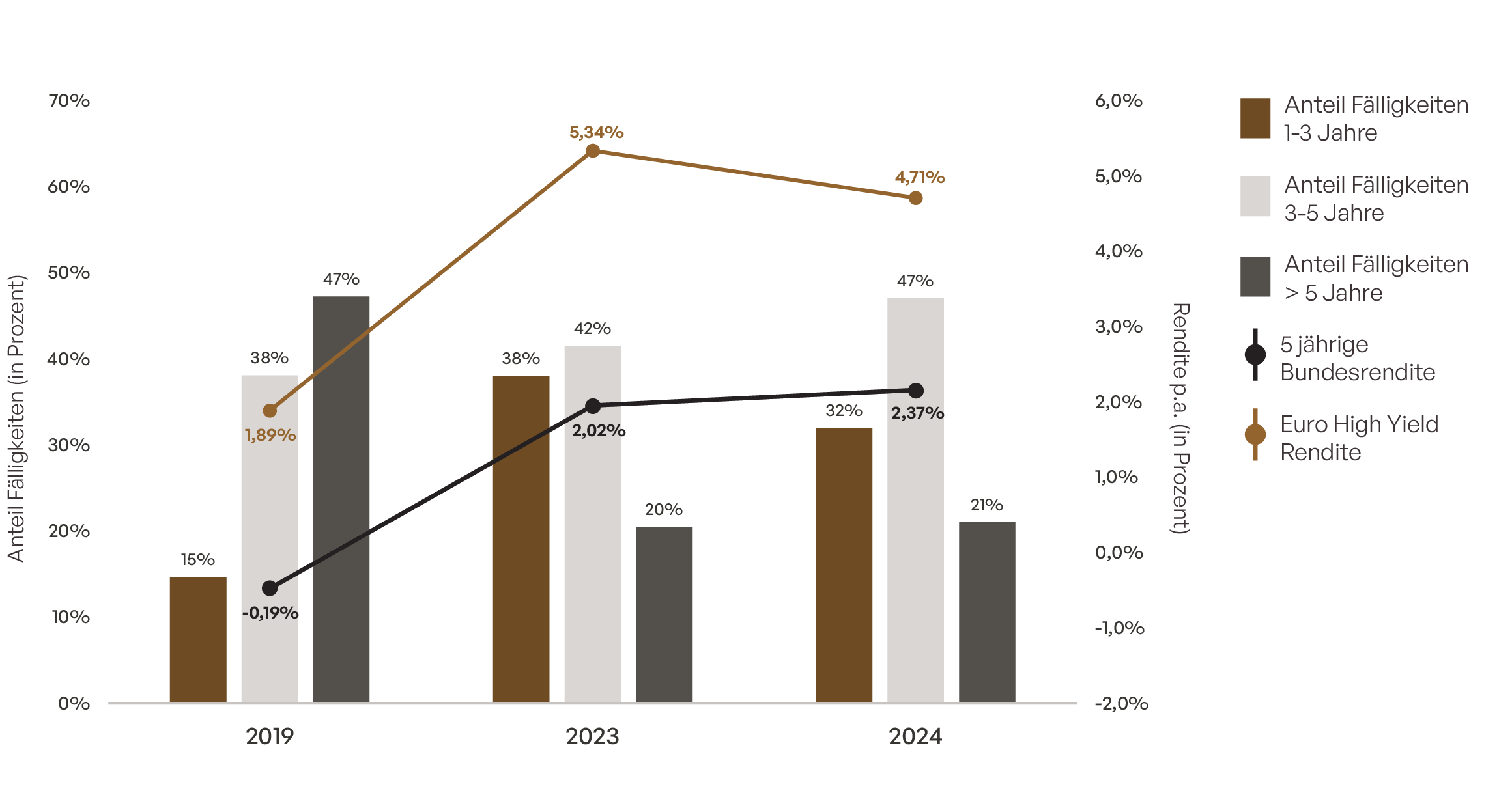
Thomas Rentsch
Senior Portfolio Manager High Yield
Following a phase of issuance strikes due to higher interest rates, new issuance of European high-yield bonds is picking up again. However, issuers remain reluctant to commit to the current yield level in the long term and prefer short and medium maturities. Will the bet on further falling yields pay off?
Recovery of new issues in the high-yield bond market despite uncertainty
Following an issuance strike in 2022 and 2023 due to significantly higher interest rates, new issuance activity for European high-yield bonds is now showing a clear recovery. Despite this revival, however, many issuers are hesitant to commit to the current yield level in the long term. This uncertainty is reflected in the structural composition of the bonds issued. Most issuers continue to prefer medium maturities of around 5 years.
Due to the increased new issue activity, the proportion of short-term maturities (in the next 1-3 years) has fallen from 38% at the end of 2023 to 32% at the end of 2024, but remains significantly higher than the level of just 15% at the end of 2019.

Source: Bloomberg (Bloomberg Euro HY ex Financials BB-B 3% Capped TR Index Hedged EUR, H23969EU Index); the distribution of the final maturities of the respective index at the end of 2019, 2023 and 2024, for hybrid bonds the maturity until coupon reset, due to the index rules there are no maturities < 1 year; High yield yield (yield to worst of the Bloomberg Euro HY ex Financials BB-B 3% Capped TR Index Hedged EUR, H23969EU Index); 5-year Bund yield source Bloomberg (GDBR5 Index)
At the same time, the proportion of long-term debt (longer than 5 years) at 21% at the end of 2024 is significantly lower than the figure of 47% at the end of 2019. This trend could be interpreted as a bet on refinancing costs falling further. Of course, issuers are mourning the refinancing costs of 2019 or 2021. However, it remains to be seen whether this corporate strategy will work.
On the risk premium side, not much further narrowing can be expected from the current level. Issuers are therefore hoping that interest rates will continue to fall in order to to reduce refinancing costs and increase the attractiveness of long-term new issues.

Source: Bloomberg (Bloomberg Euro HY ex Financials BB-B 3% Capped TR Index Hedged EUR, H23969EU Index; Bloomberg High Yield (Euro) ex Fin TR Index Unhedged EUR, I20672EU Index)
Risiken
Price losses due to increases in yields and/or higher risk premiums are possible. A total loss cannot be ruled out.
Past performance is not an indication of future results, nor can future performance be guaranteed.
Disclaimer
This marketing communication within the meaning of the German Securities Trading Act
(Wertpapierhandelsgesetz) is provided for information purposes only and should not be construed
as personal investment advice or a recommendation or solicitation to buy, sell or hold
any financial instrument or to adopt any investment strategy. The opinions and statements
contained in this document reflect the current assessment on the date of publication. This information does not constitute a complete analysis of all material facts relating to any country,
region or market. This is not to be considered as financial analysis.
If statements are made about market developments, returns, price gains or other asset
growth as well as risk ratios, these merely constitute forecasts for whose occurrence we assume
no liability. Past performance, simulations or forecasts in particular are not a reliable
indicator of future performance. Assets can go up as well as down. All information has been
carefully compiled; partly with recourse to information from third parties.
Individual details may prove to be no longer or no longer fully accurate, in particular as a
result of the passage of time, changes in the law, current developments on the markets, possibly
at short notice, and may change at any time without prior notice. Therefore, no guarantee
is given that all the information is correct, complete and up to date. Please inform yourself independently about all costs relevant to you. Maintaining a custody account may incur costs; ongoing bank charges may also be incurred. Transaction costs depend on the asset class: For government bonds and collateralised bonds such as mortgage bonds, they average around 0.02 percent, for corporate bonds 0.085 percent. For less liquid bonds, the transaction costs can also be significantly higher than 0.25 per cent. It should also be noted that transaction costs can temporarily be significantly higher during periods of market stress. For all products sold by HAGIM, all relevant cost information is made available
prior to purchase. The information is based on our assessment of the current legal and tax situation. If tax or legal matters are affected, these should be discussed by the addressee with their tax advisor
or lawyer. Investments in financial instruments are associated with both opportunities and
risks. The handling of conflicts of interest at HAGIM is published online in the legal notice on https://ha-gim.com/en/legal-information/. The information contained in this document is intended for professional clients and eligible counterparties only. This information document is not directed at US citizens or permanent residents, nor to legal entities domiciled in the USA, nor may it be distributed in the US.
